
Have you noticed that SEO is an ever-changing beast? There’s no getting away from it. Once you think you know exactly what Google is looking for, an algorithm update throws a wrench in your plan.
However, there are some proven SEO strategies that will always be in practice. By implementing these tactics on your site, you improve your chances of SEO success while also future-proofing your website against Google’s inevitable changes.
There are three ways to affect change with SEO: on-page, off-page, and technical. In this post, I closely examine these SEO techniques and how to implement them.
On-Page SEO Tips for 2023
If you’re new to SEO or looking to make quick, impactful changes, focusing your efforts on on-page SEO strategies is a great place to start.
Here are some important SEO techniques to consider when creating keyword-optimized copy in 2023.
1. Target Long-tail Keywords
Long-tail keywords are longer and more specific than the usual target keywords. As a result, they usually have a lower search volume than shorter keywords, but they are valuable.
These keywords show you why users make a particular search and not just what they’re looking for.
An example of a long-tail keyword is “how to rank on Google.” This is opposed to a short-tail keyword such as “Google ranking.”
One reason to target long-tail keywords is they tend to have higher search intent. That’s because they’re more specific, so you can narrow the keywords down to those closely related to the actions you want users to take on your site.
The intent behind these variations is very different. For example, a user posing the question “how to rank on Google,” is looking for a direct answer.
However, in a search for “Google ranking,” we don’t really know the user’s intent. Maybe they are just trying to understand what it means.
How can you effectively leverage long-tail keywords in your content?
You don’t want to include a bunch of different long-tail terms in your current content; hoping it works, as this can have the exact opposite effect of what you’re aiming for.
Here are some tips for adding long-tail keywords to your content:
- Determine the blog topics you want to cover.
- Plug each topic’s most generic phrase/title into a keyword research tool like Ubersuggest.
- Identify long-tail keywords related to your chosen topics with high search volume and low competition/CPC.
- Narrow down your list of keywords to the ones with high search intent. For example, if you are a credit card company, and one of your topics is “opening a credit card account,” a long-tail keyword you can target would be “how to open a credit card account for the first time.”
- Write relevant content that answers the user’s intent behind the chosen keyword.
2. Use Keywords in Alt Text for Images
Alt text, or alternative text, is a short description of an image, an important ranking factor in image search.
Alt text has three main uses:
- Accessibility: Alt text is read aloud with a screen reader to visually impaired users. Unfortunately, 55 percent of e-commerce sites fail to meet basic accessibility requirements.
- Context: When an image cannot load onto the page, the alt text appears as an alternative to provide context to users.
- Search engine optimization: Search engine crawlers use alt text to help them index an image properly. Google confirmed in 2021 that alt text is “still important for SEO.”

As the internet becomes more accessible, so does Google’s algorithm. This means that search engines are prioritizing accessible websites over their non-accessible counterparts. After all, the more accessible a site, the more potential for traffic.
Here are some tips for using keywords in alt text:
- Think about the image first and write a description to match it.
- Make sure your description gives a natural description of the image. On the other hand, don’t be too complex.
- Consider incorporating your target or secondary keywords in the alt-image text. For example, highlighting that an image is a screenshot of the process your content explained.
3. Use Keywords in Headers
When you place keywords in headers, you signal to search engines and users that your content satisfies the target intent behind those search terms. Just as a table of contents provides context to users, when you place keywords in headers, you do the same for search engine bots.
However, consider the user experience and Google recommendations before deciding where to place your target keywords or other variations; avoid keyword stuffing.
Here are some tips for using keywords in headers:
- Select the target keyword of your post to include in the headers.
- Plug the keyword into a keyword research tool to find other variations.
- Optimize the H1, H2, and H3 headers (aim for at least 40 percent of headers).
4. Focus on Great UX (User Experience)
Beyond keywords and content, you must consider the overall user experience (UX). This is now a vital ranking factor for Google since it started rolling out its Core Web Vitals update (more about that later).
When ranking your website, Google takes many factors into account, one of them being the time spent on the page (or dwell time). So if users are bouncing from your page within seconds of arriving, it signals to Google that it’s not the content its users want.
One thing that affects dwell time and bounce rates is how long it takes a page to load.
Research found that one in four visitors abandon sites if they take more than four seconds to load.
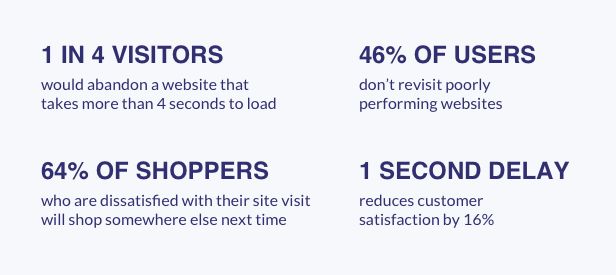
However, it’s not just page load time that affects UX. Accessibility, personalization, and navigation are just some areas you need to focus on.
Here are some tips for creating great UX:
- Ensure the content and images you use satisfy the search intent for each keyword.
- Include the most relevant information at the top of the page.
- Reduce image sizes to improve loading times for each web page.
- Make the content easy to navigate, particularly for longer content pieces. This could include adding a table of contents, clear headlines, or shorter paragraphs.
- Clean up the clutter, like redundant content, and don’t use distracting images or fonts.
5. Include Multiple Media Types
There are some things you can do that indirectly benefit your SERP rankings. One of those things is to use multiple media types across your blog.
Beyond images, media can also include audio files, ebooks, and GIFs. These media types engage users, helping increase dwell time on your website and user experience.
In addition, you can’t afford to ignore the effectiveness of video marketing, with short-form video offering the highest ROI.
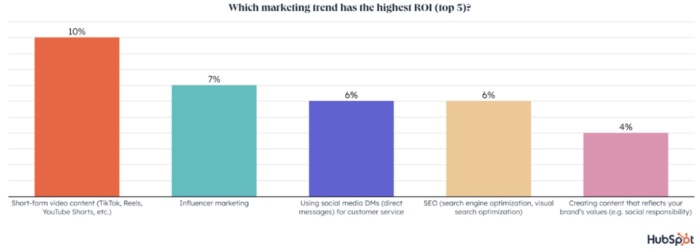
Additional research shows videos are the #1 form of media used in most content strategies, overtaking blogs; 86 percent of businesses use video marketing as a tool to grow their business.
The research also shows how video marketing is a worthwhile investment, with 92 percent of marketers reporting a positive ROI.
Audio is on the rise, too, and in recent years it has shown a strong upward momentum. To use this format, you can start by including short audio recordings in blog posts that simplify difficult concepts.
Here are some tips for including more media types:
- If you don’t have one already, create a YouTube channel as another marketing avenue to build a following.
- Embed YouTube videos that cover similar topics in relevant blog posts.
- Include audio clips from relevant podcasts that fit your topic.
- Present data and stats more engagingly, such as with visualizations and other custom graphics.
6. Use Internal Links
As you’ll read later, building backlinks are imperative to SEO success. However, you need to consider your internal link structure, too.
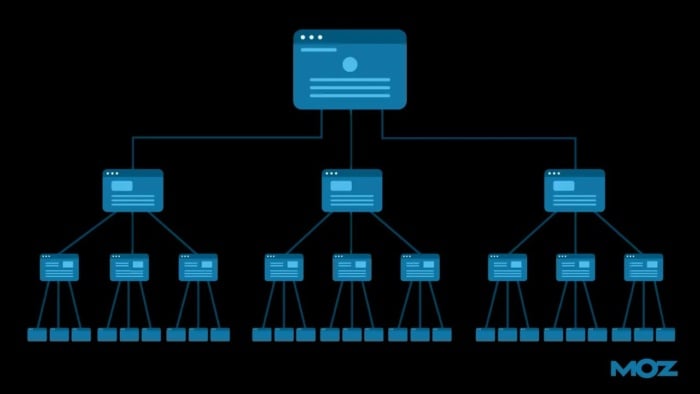
When you link to internal content, you drive your users deeper into the site. This increases the odds of them having meaningful interactions with your content (e.g., commenting on a blog post or sharing on social media), which benefits SERP rankings.
Here are some tips for incorporating and leveraging internal links:
- Choose pages with additional content relevant to the topic the user found you from.
- Use anchor text that sounds natural and encourages users to click on the next page.
- Avoid using generic anchor texts such as “click here” or “read more.” More descriptive anchor text helps Google understand how to index your page.
- As a rule of thumb, ensure the most important pages on your website are always three clicks or less away from the first page seen.
7. Focus on “Top of the Funnel” Keyword Phrases
The three main phases of the funnel are awareness, consideration, and decision.
When speaking about the top of the funnel, I mean the keyword phrases that grab prospective customers’ attention and get them to your website. In fact, 95 percent of marketers ensure they create content for their brand that targets top-of-funnel keywords.
Content that targets these terms builds “awareness” around the topic. They draw the reader in without expecting them to take action. That’s what the rest of the funnel is for.
What do these keywords look like? Top-of-the-funnel keywords tend to answer more general questions about the topic. There are many different examples of what they look like, but here is one you can refer to:
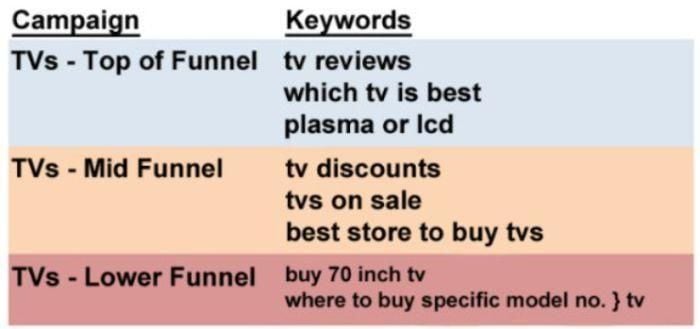
By focusing on these keywords, you’re doing two things:
- reaching a larger audience as these terms tend to have higher search volumes
- drawing in users earlier in their research process
Here are some tips for choosing top-of-funnel keywords:
- Choose terms with higher search volume and low SEO competition.
- Create a list of additional keywords related to your chosen terms that would reflect other stages of the buyer’s journey. This will help you ensure traffic generated converts into leads or sales.
- Create up to three “top of the funnel” customer personas. Based on these personas, you can ensure each search query matches the type of customer you want to sell to.
8. If You’re Thinking Local, Focus on Local SEO
How do you get keen customers ready to buy on your website? With local SEO. It’s one of those tried and tested SEO strategies that will never go out of fashion.
It makes sense.
If someone is looking for a local service or a business, the first place they’ll go is online.
They’ll likely use long-tailed keywords, so you need to use them too. It’s simple to do. Just think about the types of services or products you offer and pair them with location-specific keywords.
Here are some examples of how you can use long-tail keywords to boost your local SEO strategies:
If you’re a bakery in New York City, try using “best cupcakes in NYC” or “top-rated bakeries near me” as long-tail keywords.
These longer, more specific terms might get less search volume overall, but they’ll be much more relevant to the people who are actually looking for what the restaurant offers.
Make sure to strategically include these phrases throughout your website content and meta descriptions. Remember, do not keyword stuff local-specific keywords as that will not help your local strategy.
To further enhance your SEO, you’ll also want to:
- Claim your Google Business Profile and use it as a storefront.
- Optimize your website for local keywords and phrases that potential customers might use. This could include adding location-specific information, such as city or state names to your meta descriptions, titles, and page content.
- Ensure that your website is mobile-friendly, since many people now use their smartphones to search for local businesses on the go.
- List your business in online directories like Yelp!
Another effective strategy is building strong backlinks from reputable websites in your industry or community.
Content SEO Tips for 2023
Content marketing is one of those tried and tested SEO strategies, and one of the best things you can do for your online visibility is to keep that at the forefront of your mind when creating content.
Here are some SEO techniques to help you achieve this
9. Have a Master List of Topics (and Relevant Long-tail Keywords)
It’s essential to have a master list of topics and relevant long-tail keywords at your disposal.
Why?
Well, for one thing, you won’t find yourself staring at a blank screen, wondering what to write about next. Instead, you’ll have a list of ideas ready to write up and keep your blog filled with fresh content.
Additionally, when you have relevant long-tail keywords associated with each topic on your list, optimizing your content for search engines and attracting organic visitors becomes easier.
Looking for inspiration? Here are some suggestions for getting content ideas:
- Start with a keyword search. Then, use tools like Ubersuggest or expand your search to topic clusters with the social listening tool AnswerThePublic.
- Use Google Trends to see what topics people are actively searching for.
- Look at your published content. Which posts are engaging your visitors and driving results? Publish more of the same.
- Answer users’ questions. Address user intent by including long-tail keywords in your headlines and content.
- Complete an SEO analysis to find keyword and content gaps.
- Keep up with trends. Content marketing trends are constantly changing. Keep up-to-date so you always have a list of hot topics available.
10. Build A Content Calendar And Stick To It
Do you struggle to publish blog posts and social media updates at the last minute? Fear not. Building a content calendar can help you stay organized and on top of your SEO strategies.
A content calendar is a schedule that outlines the topics, types of content, and publishing dates for all your future posts. It helps you plan, avoid duplication, and track significant events or holidays that inspire relevant content.
One good starting place is seasonal trends, like Valentine’s Day.
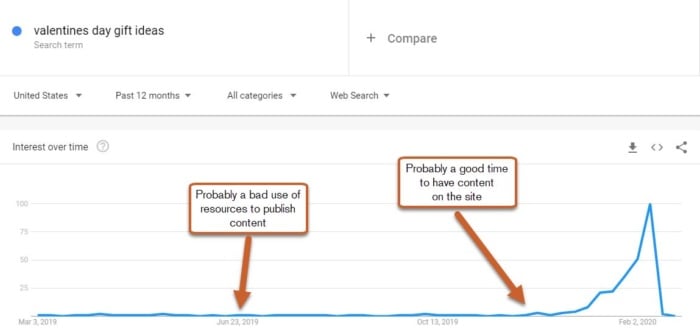
Here are some tips for setting up a content calendar.
- Determine your goals: Identify what you want to achieve before creating a content calendar. For example, are you looking to increase website traffic, generate leads, or establish thought leadership? Once you clearly understand your objectives, map out topics that align with those goals.
- To start building your calendar, consider what topics are relevant and engaging for your audience. This could include industry news, how-to guides, product reviews, or even behind-the-scenes glimpses into your business. Make sure to keep in mind any seasonal topics that would be relevant to your business.
- Next, decide on the frequency at which you’ll be posting new content. Depending on your resources and team size, this could range from daily or weekly posts to monthly updates.
- Conduct keyword research: Conduct thorough keyword research to ensure your content is optimized for search engines. Use tools like Ubersuggest, Google Keyword Planner, or Ahrefs to determine which keywords are most relevant and valuable to target.
- Establish themes: Organize your topics into overarching themes that align with your SEO strategies and business objectives.
11. Audit Existing Pages For Refreshes
One of the most effective SEO strategies is to audit existing pages and refresh them regularly. That way, you can keep them updated with the latest stats and new target keywords and freshen up your meta tags.
One of the significant benefits of refreshing your website’s content is improving search engine rankings. In addition, updating old or outdated content with new and relevant information helps you keep pace with Google’s Freshness Algorithm.
Here are some tips for conducting an audit:
- Run a full scan of your website using an online tool like Ubersuggest, Semrush, or Ahrefs. This will help identify any technical issues that may be affecting your search engine rankings. For example, look for broken links, slow-loading pages, and missing meta descriptions or alt tags on images.
- Assess each page’s performance. Review metrics such as traffic, engagement, bounce, and conversion rates. Take note of the pages performing well and those needing improvement.
- Look at your competitor’s sites to see how they rank for similar keywords.
- Next, analyze the content on each page of your site. Does it contain relevant keywords and provide value to readers? Remember that quality is more important than quantity; aim for well-written articles rather than keyword-stuffed fluff pieces.
- Now, look at your content. Is it relevant and engaging? Are your keywords properly placed throughout? Do all pages have unique meta descriptions and title tags that stand out on the SERPs?
12. Deliver Best-In-Class Content Every Time
It’s too easy for your content to get lost in the sea of online noise. Whichever niche you’re in, numerous other blogs likely have already covered your topic. However, that doesn’t mean you can’t create amazing content.
Here are some tips for outperforming your clients:
- Identify your target audience and their pain points. When you tailor your content to the needs and interests of your audience, you make it more personalized and engaging for them. Add practical advice, answer questions, and include informative, actionable content.
- Decide on your keywords. Use a mix of phrases and keywords; include low competition and long-tail keywords.
- Delve deeper. Do a competitive analysis. What are their posts missing? Then, fill the gap with your content.
- Ensure you have a content strategy. You need to post with a purpose if you want to achieve your business goals.
- Focus on the structure of your content. Make it easy to scan with bullet points, vary the length of your sentences, and add plenty of images, graphics, and videos to keep your audience engaged.
- Use original sources and stats, and keep them updated.
- Take time with your headlines. Make them short and descriptive. Ensure they’re unique, urgent, and useful. Add keywords for visibility and numbers and stats for interest.
- Gather your research, outline your content, and craft your article. Then leave it for 24 hours before reviewing it with fresh eyes.
Technical/Off-Page SEO Tips for 2023
Are you looking for ways to bolster your website’s search engine rankings? Then you need to focus on some off-page SEO strategies.
Below are some techniques to assist your off-page SEO.
13. Adapting to the Changes
Do you know one of the biggest mistakes that any business can make? Failing to move with the times.
If a brick-and-mortar store doesn’t keep up with trends, it won’t be long before the owners notice the difference in their bottom line. It’s the same for online sellers.
Adapt your SEO strategies to the time of year and what your prospects are looking for.
For instance, as a hotel owner, your ideal customer might be looking for a “New York short holiday break,” but in February, they may search for “Weekend Valentine’s Day break New York.”
Creating content throughout the year to match search intent makes you more likely to secure your perfect customers.
However, it’s not just seasonal trends you need to consider. Industry changes, global events, and algorithm updates are all reasons to take a second look at your online marketing.
Here are some tips for adapting your SEO strategy:
- Change your approach along with the seasons, special occasions, and developing trends.
- Use keyword tools like Ubersuggest to find trending keywords and long-tail keywords and create content around them.
- Perform competitive research analysis to see which keywords others are using and which content is getting results for them.
- Keep up-to-date with industry and search engine changes and adapt your plan accordingly.
14. Build Your Brand
Since the late 2000s, Google has increasingly put an emphasis on brands. In particular, it looks for brand signals to weed out misinformation and provides more reliable results for each search. This makes branding a critical ranking factor.
From experience, I’ve seen huge increases in traffic thanks to the growth of my brand.
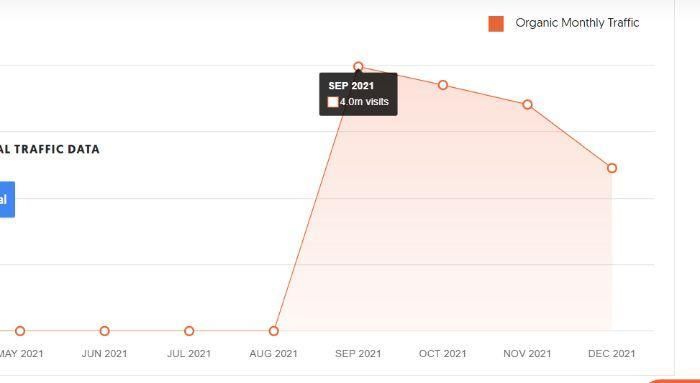
When a brand is consistently represented across all of its platforms, it can increase revenue by up to 20 percent.
With the establishment and growth of your brand, you get more traffic from non-branded and branded terms. That’s why I see millions of organic views each month!
Here are some tips for building your brand:
- Figure out what social platforms your target audience uses and tailor your strategy accordingly! 270.1 million Americans use social media, so you need to be comfortable using it to promote your brand.
- Think about forming a partnership with a complementary brand. For example, Lego and IKEA formed a partnership that benefitted them both. Approach companies whose products or services complement your brand and see if you can work together.
- As you plan your brand awareness campaign, highlight your brand’s personality, story, and values. Talk about more than just what you sell. This will resonate with your target audience more!
15. Create Thought Leadership and Strategic Content
Once you have solid pillar content (i.e., content targeting relevant keywords) on your website, it’s time to think strategically and start building authority.
How do you do that? With thought leadership and strategic content.

According to research, 65.4 percent of businesses include thought leadership pieces in their content marketing mix, while 29.5 percent plan to add them.
Additionally, 54 percent of decision-makers say they spend more than one hour per week reading thought leadership content relevant to their business. At the same time, 71 percent say that less than half of their reading provides valuable insights.
That gives you a massive opportunity with this type of content. It requires you to look ahead and answer questions that aren’t even being asked yet. You can achieve this by speaking directly with industry leaders and subject matter experts to get ahead of the curve.
While leadership and authority content takes more time and effort to create, it’s well worth it. When you write content that others look to, it builds your brand and increases your backlink portfolio.
Here are some tips for creating thought leadership and more strategic content:
- Look for trends on where your industry is going in the next 5-10 years and make content that speaks to them.
- Consider frequently asked questions in your industry that you can address with data. Identify topics where you have the capability and resources to provide relevant data points.
- Do some internal or external research and create content that highlights your findings. This helps establish you as an industry leader, which can lead to more backlink opportunities from other sites citing your content.
- Set Google alerts to stay up-to-date on news and events that affect your industry. Then, be one of the first to write and present your views on the topic, backed by valuable insights.
16. Diversify Your Backlink Profile
What does it mean to diversify your backlink profile? In short, you want as many links as possible from as many websites as possible.
An Ahrefs study looking at more than 1 billion web pages found 66.31 percent had zero referring domains, and 26.29 percent only had one to three referring domains. As such, an incredible 90.63 percent of content doesn’t get any Google traffic.
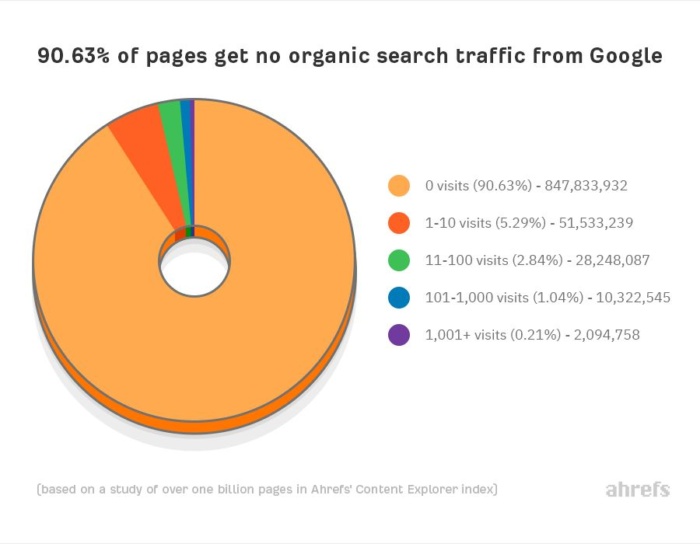
When getting backlinks, you want to ensure the type of anchor text copy used varies. Some examples of different variations to look out for include the following:
- Branded anchor text: “According to Neil Patel…”
- Long-tail anchor text: “…we should consider the future of SEO.”
- Naked link anchor: “https://neilpatel.com/blog/the-future-of-seo/”
As outlined in a previous section, my backlink checker is an excellent way to get this information.
Here are some tips for diversifying your backlink profile:
- Try to get links from directories and other resource roundups to diversify links.
- Reach out to websites that would be a natural fit for your brand. Ask them to link to you and vice versa.
- Run a report on your competition to find backlinks and where they get them. Then, target those websites or similar ones to link back to you.
17. Use Subject Matter Experts to Increase Your E-E-A-T Score
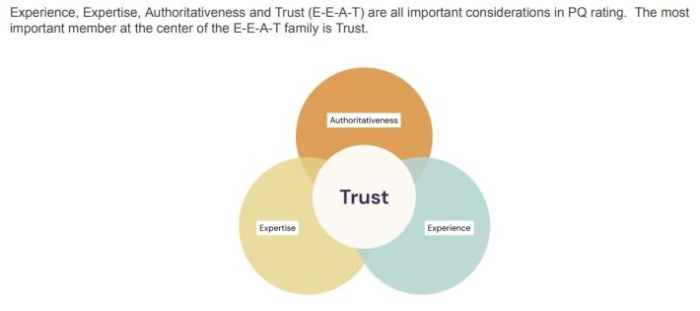
For years, EAT (expertise, authority, and trust) was one of the top acronyms for creating content. However, Google has added an extra branch to this: Experience.
An E-E-A-T score is one of the most important factors determining page quality. While you don’t have to be an expert or authority on each topic you write about, you should emulate those individuals to create content that gets a higher score.
Forty-seven percent of buyers read three to five pieces of content before engaging with a sales representative. Connecting with subject matter experts or emulating their content increases the chances of a buyer engaging with your content before moving to the next stage.
Whether you’re creating thought-leadership content yet or not, you can still look to subject matter experts for help. While interviews with such people are best, they’re not the only way to “borrow” their authority.
You can also link to interviews done by other content creators, insert quotes from subject matter experts in your posts, or highlight other content forms the subject matter has done, such as videos, podcasts, or infographics.
Here are some tips on using subject matter experts to improve your E-E-A-T score:
- Find subject matter experts through professional directories such as trade publications, search on LinkedIn, and join related Facebook groups.
- Make sure the subject matter expert you focus on is the right fit for your target audience.
- If your chosen subject matter expert has little time, be flexible with how you work with them. For example, this could be simply asking them to review your content for accuracy and then crediting them on the page.
18. Identify Your SEO Competitors and Monitor Them
Are you looking to improve your SEO strategies and outrank your competition? One way of maximizing your success is identifying who your competitors are. That means finding businesses or websites operating in your niche and targeting the same audience with similar keywords.
It’s easy enough to start finding your competitors. Just search Google, LinkedIn, or social media. Alternatively, sign up for Google Alerts for competitor mentions.
Tips for identifying and monitoring your competitors:
- Keep an eye on their website structure, backlinks, content creation process, and social media presence. This information can help you identify potential areas for improvement in your strategy while keeping up with the latest trends.
- Conduct a thorough search of keywords related to your business and take note of the websites that appear on the first page. These websites are likely your top competitors as they already have strong SEO strategies.
- Analyze their website design and content structure. This gives you an idea of what works for them and what changes you need to improve your ranking.
19. Work To Make Sure Your Pages Pass Core Web Vitals
Core Web Vitals (CWV) encompasses three main metrics: loading speed, interactivity, and visual stability.
Loading speed measures how quickly a page loads; interactivity measures how long it takes for users to interact with the page; and visual stability measures whether page elements move around unexpectedly or cause layout shifts as it loads.
Although CWVs are essential to UX, only 39 percent pass Core Web Vitals metrics, with the remaining 61 percent falling below the threshold.
To see how your CWVs measure up, you can check Google Search Console.

Here are some tips to improve Core Web Vitals
- Prioritize page speed optimization. This metric is measured by Largest Contentful Paint (LCP), which calculates how long it takes for a page’s main content to load.
- Assess visual stability by ensuring that elements don’t shift around as the page loads or while users interact with it.
- Another effective strategy for boosting core web vitals is reducing unnecessary JavaScript and CSS code. This will improve loading times and make it easier for search engines to crawl and index your site.
- Complete a technical SEO audit to measure page load times.
- Work on enhancing interactivity using features such as lazy loading or infinite scrolling. These techniques can improve the user experience while also reducing page load times.
Bad SEO Practices to Avoid in 2023
Now that we’ve gone through the most important ways you can dominate Google with better SEO strategies in 2023, let’s focus on some things to avoid.
Not much has changed here, but all of these are still practices that can harm your SERP rankings.
20. Keyword Stuffing
Keyword stuffing means stuffing as many keywords into a piece of content as possible. The idea is that the more keywords an article has, the more relevant the content appears and the higher it’ll rank on SERPs. The exact opposite is true, though.
When a keyword appears too often on a page, the page gets flagged as spammy by Google’s crawl bots, negatively affecting rankings.
The easiest way to avoid this is to aim for 0.5-2.5% of keyword density. This goes for both the main keyword and keywords on the topic.
21. Keyword Cannibalization
Keyword cannibalization occurs when two or more site pages target the same primary keyword. This is common on newer websites where the owner may think splitting up larger pieces of content is better to create more pages.
For example, if your target keyword is “meringue,” and you create one post on “How to Make the Perfect Meringue” and another post on “X Common Mistakes When Making Meringue.” To avoid cannibalization, you should create a larger post that includes both titles as H2s. This is known as pillar content.
SEO techniques to avoid keyword cannibalization:
- Conduct thorough research on relevant keywords related to your business. Determine which phrases will likely have the most impact and assign them to specific pages on your website.
- Use tools like Ubersuggest or Google Analytics to determine which pages are performing well and which ones need improvement.
- Another effective technique is using long-tail keywords instead of broad terms. As explained earlier, long-tail keywords are more specific and niche-focused, making it easier for search engines to match user queries with relevant content.
22. Duplicate Content
Somewhat related to keyword cannibalization is duplicate content. There’s been plenty said about it and how the algorithms treat it.
Duplicate content is substantive blocks of content that match or are similar to other content elsewhere on the site or across the internet. Does that mean the search engines penalize your content? No.
However, it does mean that search engines like Google may index the wrong page, or it can affect your content’s rankings.
To prevent Google from flagging content on your website as duplicate, use the following tips:
- Create 301 redirects.
- Keep a consistent URL structure.
- Use top-level domains.
- Use the noindex tag on syndicated content
23. Exact Match Anchor Text
Like keyword stuffing, you don’t want exact-match anchor text phrases to show up too often in your content. Why? It’s a clear signal to search engines that you’re trying to manipulate rankings.
To avoid this practice, you first need to determine the current status (i.e., partial versus exact) of any and all links back to your site. You can do so with Ahrefs’ Site Explorer, but you’ll need a subscription.
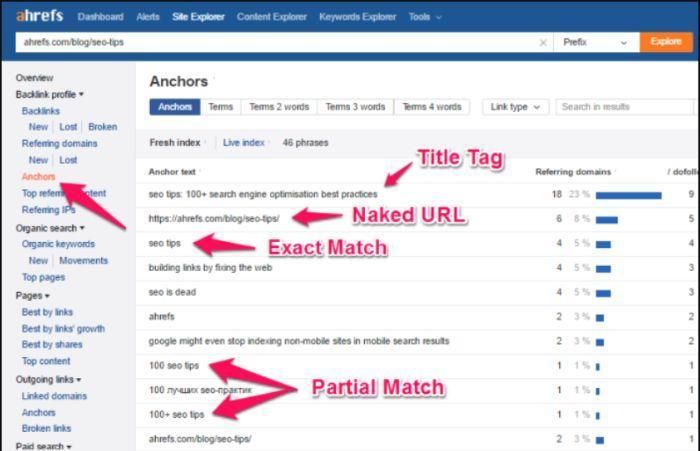
The goal is for only 10-20 percent of all referring domains to link exactly or partially.
If you’re not actively link building, then it’s unlikely you’re in danger of this particular misstep. However, it’s always good to keep a pulse on your backlink portfolio.
24. Spammy Link Building
It used to be that backlinks were the hidden treasure of SEO success. Indeed, backlinks are still a major ranking factor for Google, but the quality of those backlinks is now more critical than ever.
In 2021, Google rolled out another algorithm update that targeted and devalued bad backlinks. While no sites were individually penalized in the process, it stopped counting a lot of backlinks that many sites had grown accustomed to, which affected rankings.
If you’re a website owner, you’ve probably received some requests for backlinks in the past. Sometimes they even offer to pay you to do so. However, in almost all cases, the requests come from website owners with a lower domain authority score than yours or might use shady SEO practices.
Therefore, vetting all backlink requests is vital to ensure they won’t impact your site. How can you know what sites are linking to you and compare them to your competition? With my backlink checker tool, enter the domain URL, and you’ll receive a complete overview of your backlink profile:
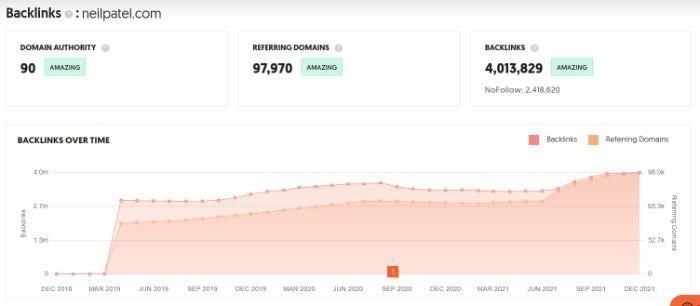
You can also get more granular and see each linking site, their domain authority, and the anchor text they used to link to you:

Here are some tips to eliminate spammy backlinks:
- Run an audit to see what backlinks your website is currently receiving.
- Before you disavow an undesirable backlink, try contacting the website and asking them to remove it.
- Per Google, any websites that offer affiliate links to your site need to qualify the links – so be sure to ask any affiliates to add the correct HTML tag.
25. Writing For Search Engines Instead Of Human Users
Of course, you need to write for users searching online. However, you must also consider the search engines and how they work.
That means including meta tags, keywords, and other common SEO methods, but in a way that makes sense and adds value to your audience.
To do this, you only need to worry about creating quality content that resonates with your audience. Then, combined with your search tags and other common SEO strategies, you give search engines and consumers what they need.
Here are some tips for writing for search engines:
- Pay special attention to your headlines and meta descriptions; make them descriptive and engaging, and include keywords.
- Ensure your content is well-structured and easy to read.
- Include clear, descriptive subheadings.
FAQs
Search listings are free on Google. Search rankings are based on Google’s algorithm, and no one can pay for a better ranking.
Assuming you are using the most common practices outlined in the article, it can take some time to implement all optimizations on your website. How long will depend on the size of your site and human resources. As for how long it takes to start seeing organic results, the consensus is four to six months.
The key to any successful SEO strategy is to focus on white hat techniques that have been proven to work. These are all outlined above.
Google releases thousands of algorithm updates every year. As for recent updates, Google has announced a core update and a product reviews update.
There are also plans for several more updates in 2023.
Conclusion
As much as things change regarding Google’s algorithm and SEO, one thing remains constant: relevant, high-quality content is always a solid place to start.
By implementing the on-page, off-page, and technical SEO practices above, you can be sure to dominate SEO with Google. Why? Because these techniques help you to improve your content for both users and crawl bots to ensure a clean, engaging experience.

See How My Agency Can Drive More Traffic to Your Website
- SEO - unlock more SEO traffic. See real results.
- Content Marketing - our team creates epic content that will get shared, get links, and attract traffic.
- Paid Media - effective paid strategies with clear ROI.

Unlock Thousands of Keywords with Ubersuggest
Ready to Outrank Your Competitors?
- Find long-tail keywords with High ROI
- Find 1000s of keywords instantly
- Turn searches into visits and conversions
Free keyword research tool
